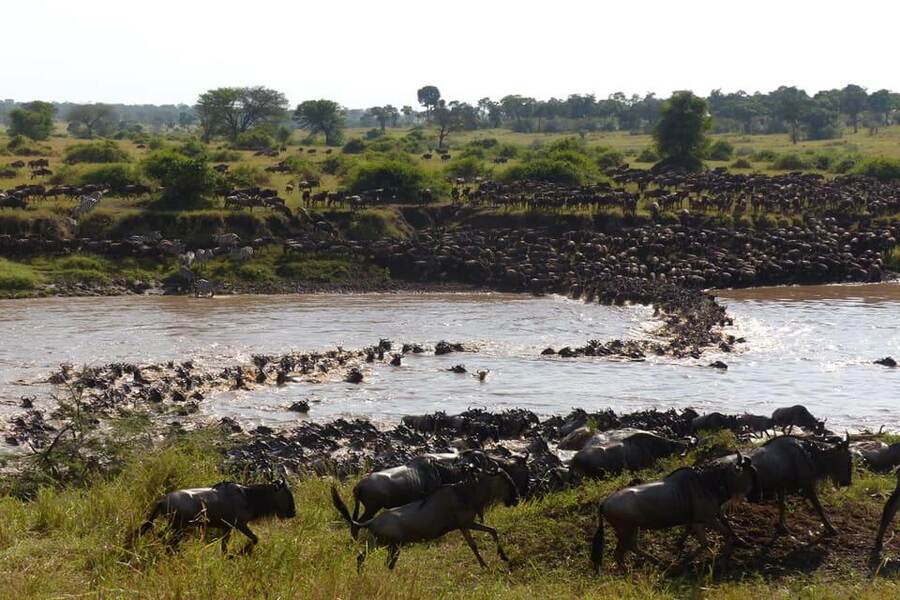Your Serengeti Central Safari in the Seronera Valley offers a year-round game-viewing holiday with impressive populations of bovids, terrestrial predators, reptiles, amphibians and birds, which remain even after the spectacular hordes of blue wildebeests and zebras have gone.
Central Serengeti’s Seronera Valley is a year-round game-viewing Holiday with impressive populations of bovids and predators which remain even after the spectacular hordes of blue wildebeests and zebras have gone. There are several species of hyrax, diminutive cousin of the elephants, hares, elephant shrew and other rodents, many of them red-listed as threatened species, hundreds of bright reptiles and amphibians, and birds in an astonishing variety from gigantic puffed up bustards to the jewel-like sun birds. The endless variety of landscape explains the diversity of wildlife to be seen during a Serengeti Central Safari with Mkama Tours to Tanzania. Volcanic in origin, the terrain has weathered over time to form distinctive areas. The low hill ranges contains black clay pans, which support acacia trees and the giraffe that browse on them. Central grasslands teem with varied herbivores including elands, impalas, buffalos, topis, hippos, and also their predators, hyenas, lions, leopards, cheetahs and other small cats
Thick woodland is home to several varieties of primates from vervet monkeys, olive baboons to bushbabies. The wild dog, officially declared extinct in 1991, is reported to have been seen in this area. On the plains, elephants are plentiful where matriarch herds are increasing in certain areas. Moru Kopjes loom from the sweeping savannah like ships on a golden-green sea. In addition to their matchless flora, weird candelabra trees and dazzling ephemeral flowers, the fauna include rare black rhino. Round off your exploratory trip in the wilds of Serengeti by climbing and playing the gong rock, and to admire Maasai cave paintings of elephants, shields and abstract patterns. The kopjes also provide a superlative vantage point from which to observe the massed bovids plunging past to their northern and western migratory course in April, May, preoccupied with the urgency of the rut as males select their harems and defend their territories. You can also see them in dissected herds on way south to calve around December and January.
Day 1: Arusha – Ngorongoro
Non game-viewing travel time: 4 hours
Distance: 190 km
Pick up from Arusha and transfer to the Ngorongoro Conservation area. We arrive in time for lunch at the lodge and after lunch we will descend over 600 meters into the crater to view wildlife for an afternoon safari tour.
Supported by a year round water supply and fodder, the Ngorongoro National Park supports a vast variety of animals, which include herds of wildebeest, zebra, buffalo, eland, warthog, hippo, and giant African elephants. Another big draw card to this picturesque national park, is it’s dense population of predators, which include lions, hyenas, jackals, cheetahs and the ever-elusive leopard, which sometimes requires a trained eye to spot. We will visit Lake Magadi, a large but shallow alkaline lake in the south western corner, which is one of the main features of the crater. A large number of flamingos, hippos and other water birds can usually been seen here.
Dinner and overnight as per the standard and type of accommodation option requested.
Day 2: Ngorongoro – Serengeti (Lobo area)
Non game-viewing travel time: 5 hours
Distance: 250 km
After breakfast we will head towards the Serengeti National Park, leaving the highlands behind, we descend into the heart of wild Africa – the Serengeti National Park – with its endless plains, rolling into the distance as far as the eye can see. We head to the Lobo area which is located just north of the Seronera area (central Serengeti National Park). The wildebeest migration, normally pass through the Lobo area every year around July / August en-route to the Kenya’s Masai Mara Game Reserve and again in late October / November en-route to the southern Serengeti National Park.
We arrive in time for lunch and enjoy an afternoon game drive in the Serengeti National Park.
Dinner and overnight in the Lobo area, as per the standard and type of accommodation option requested.
Day 3: Serengeti (Lobo area)
After breakfast, enjoy a full day game drive in the Serengeti National Park. The area around Lobo and the Grumeti River has good resident game throughout the year. Non-migrating game like elephant, buffalo, gazelle, zebra, lion, leopard and cheetah can be seen here all year round. The game viewing is very good and you can follow game for long periods without seeing other vehicles – truly one of the forgotten corners of the Serengeti Plains. Magnificent riverine trees can be found along the river lines and bird life such as kingfishers and fish eagles can be found here.
Dinner and overnight in the Lobo area, as per the standard and type of accommodation option requested.
Day 4: Serengeti (Lobo area) – Northern Serengeti (Wagakuria area)
Non game-viewing travel time: 3 hours
Distance: 150 km
After breakfast we head towards the far northern reaches of the Serengeti National Park, also known as the Wagakuria. We will do a game drive en-route from the Lobo area to the Wagakuria area. As we head north, good sightings of giraffe, plain game, herds of buffalo and elephants can often be seen.
We arrive in time for lunch at the lodge and after lunch will we enjoy an afternoon game drive in the area. The wildebeest migration can normally be found in the Wagakuria area from August to October, depending on rainfall patterns. A long stretch of the Mara River runs through the northern Serengeti National Park and the Mara River provides the migration with its most difficult obstacle. Witnessing the frantic herds of wildebeest crossing the Mara River is amazing.
Dinner and overnight in the Wagakuria area, as per the standard and type of accommodation option requested.
Day 5: Northern Serengeti (Wagakuria area)
After breakfast enjoy a full day game drive in the Wagakuria area. Resident wildlife numbers are exceptionally high in the Wagakuria area, with prides of lion up to 30 strong, however from August to October the area turns into a wildlife paradise. The key feature is the Mara River and it is not uncommon to see the herds cross the Mara River north on one day and then back south a few days later. Please take note – to actually finding a crossing is very difficult and is sometimes a matter of luck. A herd can be seen next to river and only decide to cross or not cross until a couple of days later. This area is a stunning region with kopjes, woodland, riverine vegetation and open plains, similar to Kenya’s Masai Mara Game Reserve.
Dinner and overnight in the Wagakuria area, as per the standard and type of accommodation option requested.
Day 6: Northern Serengeti (Wagakuria area) – Arusha
After breakfast at the lodge, we depart to the Kogatende airstrip and enjoy a game drive en-route to the airstrip. The group should tip the guide around $20 to $ 30 a day
Around mid-morning, join a scheduled flight from Kogatende airstrip to Arusha airport. Upon arrival to Arusha airport, meet our driver and transfer to Arusha town. On arrival in Arusha will we have lunch and then we will end our African safari adventure. You will be taken to your hotel, which ends our safari services.



